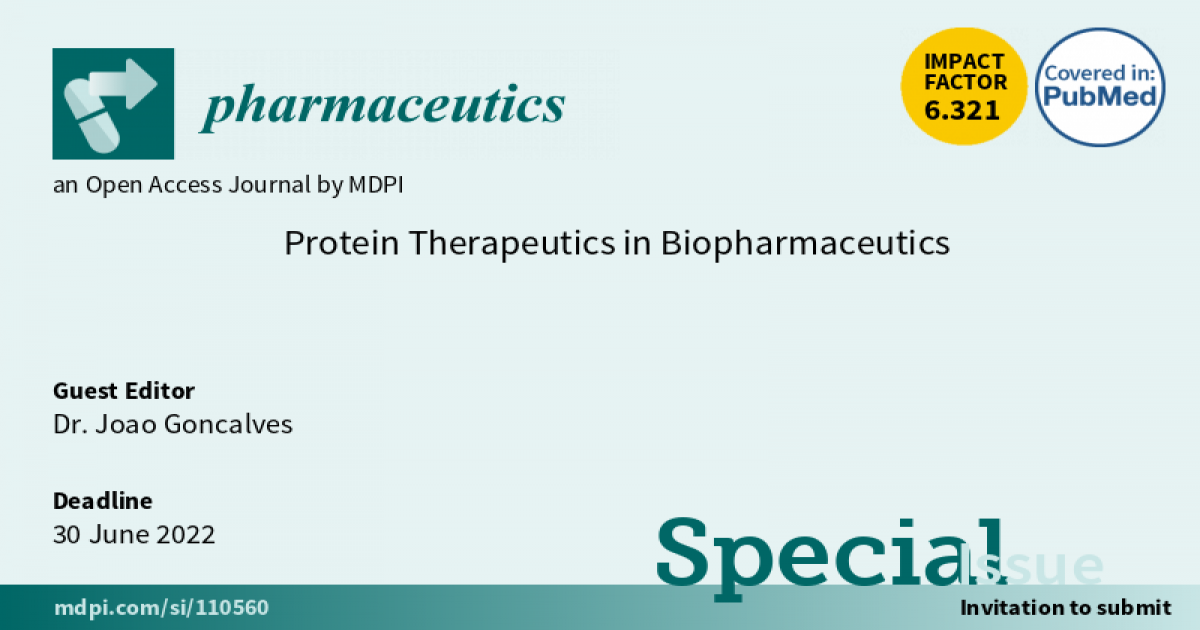Protein Therapeutics in Biopharmaceutics
A special issue of Pharmaceutics (ISSN 1999-4923). This special issue belongs to the section "Biopharmaceutics".
Deadline for manuscript submissions: closed (30 June 2022) | Viewed by 13204

Special Issue Editor
Interests: therapeutic antibody development
Special Issues, Collections and Topics in MDPI journals
Special Issue Information
Dear Colleagues,
Protein drugs are the most active and fast-growing part in the field of drug research and development, and one of the most promising industries in the twenty-first century. Therapeutic protein drugs are an important class of medicines serving patients most in need of novel therapies. Protein drugs are developed to treat a wide variety of clinical indications, including cancers, autoimmune diseases, inflammation, diabetes neurodegenerative effects, exposure to infectious agents, and genetic disorders. Recent approved recombinant protein therapeutics has been used to target specific sites. A confluence of computational and high-throughput experimental methods for protein-engineering and “off the shelf” platform technologies has ushered in unprecedented opportunities to develop safe, effective, and more convenient protein therapeutics.
In this Special Issue, we invite authors to report their recently developed protein-based strategies for diagnosis and/or treatment of various disease states. We also welcome reviewer articles with expert opinions and perspectives in the protein therapeutics in biopharmaceutics field.
Dr. Joao Goncalves
Guest Editor
Manuscript Submission Information
Manuscripts should be submitted online at www.mdpi.com by registering and logging in to this website. Once you are registered, click here to go to the submission form. Manuscripts can be submitted until the deadline. All submissions that pass pre-check are peer-reviewed. Accepted papers will be published continuously in the journal (as soon as accepted) and will be listed together on the special issue website. Research articles, review articles as well as short communications are invited. For planned papers, a title and short abstract (about 100 words) can be sent to the Editorial Office for announcement on this website.
Submitted manuscripts should not have been published previously, nor be under consideration for publication elsewhere (except conference proceedings papers). All manuscripts are thoroughly refereed through a single-blind peer-review process. A guide for authors and other relevant information for submission of manuscripts is available on the Instructions for Authors page. Pharmaceutics is an international peer-reviewed open access monthly journal published by MDPI.
Please visit the Instructions for Authors page before submitting a manuscript. The Article Processing Charge (APC) for publication in this open access journal is 2900 CHF (Swiss Francs). Submitted papers should be well formatted and use good English. Authors may use MDPI's English editing service prior to publication or during author revisions.
Keywords
- therapeutics
- protein Delivery
- protein Production
- theranostics
- synthetic proteins
- targeting
- protein degradation
- imaging
- protein Engineering
- gene Edition
- gene Regulation
- chimeric Proteins
- protein conjugates
Benefits of Publishing in a Special Issue
- Ease of navigation: Grouping papers by topic helps scholars navigate broad scope journals more efficiently.
- Greater discoverability: Special Issues support the reach and impact of scientific research. Articles in Special Issues are more discoverable and cited more frequently.
- Expansion of research network: Special Issues facilitate connections among authors, fostering scientific collaborations.
- External promotion: Articles in Special Issues are often promoted through the journal's social media, increasing their visibility.
- e-Book format: Special Issues with more than 10 articles can be published as dedicated e-books, ensuring wide and rapid dissemination.
Further information on MDPI's Special Issue polices can be found here.






